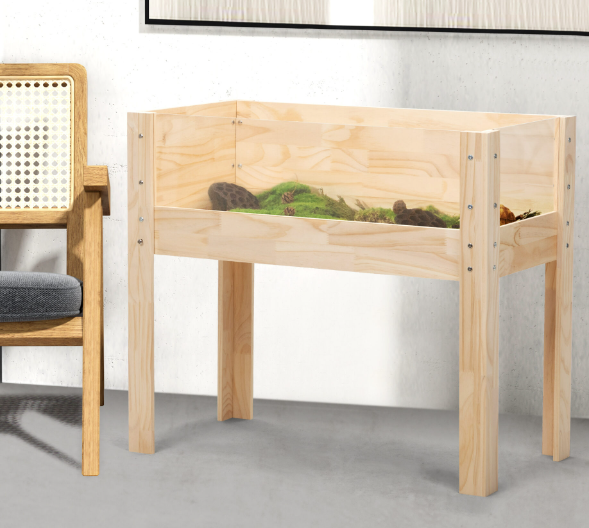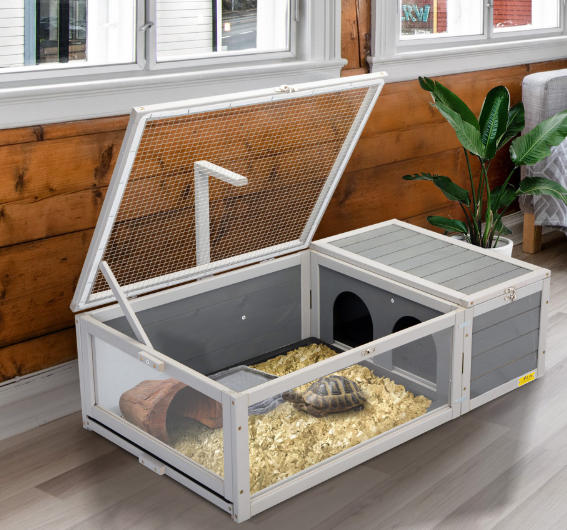Coziwow turtle habitat provides a spacious and comfortable living space for your beloved pets to swim and rest to their heart’s content. Our meticulously designed one is made with high-quality materials, offering a safe and warm haven for your turtles. With various sizes and styles available, Coziwow’s turtle habitat accommodates different types and sizes of turtles, enabling you to create an ideal living environment for your shelled companions. Choose Coziwow to provide the perfect habitat for your turtles, allowing them to enjoy a life of comfort and happiness. Click the link now to explore more about Coziwow’s habitat of a turtle series and create a cozy and comfortable home for your adorable turtles.
Content

Space and Zones of Turtle Habitat
Space Matters
One of the foundational aspects of turtle habitat design is providing ample space. Unlike some misconceptions, turtles are not meant for cramped living conditions. A spacious enclosure allows them to exhibit natural behaviors, explore their surroundings, and exercise. Consider the size of your turtle species when planning the enclosure. Small turtles may need a minimum of 10 gallons of water per inch of shell, while larger species may require significantly more. Combining both aquatic and terrestrial areas within it caters to the diverse needs of different turtle species.
The Importance of Hiding Spots
Turtles, despite their seemingly tough exterior, often seek refuge and privacy. Incorporating hiding spots within the turtles habitat is essential for their mental well-being. Utilize plants, decorations, or purpose-built shelters to create hiding spots where turtles can retreat when feeling stressed or threatened.
Substrate and Environment of Turtle Habitat
Dual Environment
Turtles are unique creatures with both aquatic and terrestrial tendencies. Therefore, a well-designed habitat of a turtle should have a balanced combination of both environments. A portion of the enclosure should be dedicated to a swimming area with clean, dechlorinated water, while another section should mimic a natural land habitat. Providing basking spots, such as rocks or logs, allows turtles to regulate their body temperature effectively. This dual-zone setup ensures that turtles can express their natural behaviors and switch between aquatic and terrestrial activities as they please.
Choosing the Right Substrate
The substrate, or the material covering the floor, is a critical element in turtle habitats design. For aquatic areas, choose a substrate that is easy to clean and doesn’t pose a risk of impaction if ingested. River rocks or smooth gravel are popular choices. On the terrestrial side, opt for a substrate that allows digging and burrowing, such as coconut coir or cypress mulch.

Enrichment and Nutrition
Enrichment and Stimulating Activities
A well-designed indoor turtle habitat goes beyond the basic necessities; it also includes elements of enrichment. Incorporate items like floating platforms, puzzle feeders, or objects for climbing. These additions stimulate your turtle’s mind, prevent boredom, and promote a healthier, more active lifestyle.
Nutrition and Feeding Stations
A well-balanced diet is crucial for the health of your turtle. Research the dietary needs of your specific species and provide a variety of foods, including commercial pellets, leafy greens, and occasional live prey. Create designated feeding stations in wood turtle habitat to prevent food from contaminating the water and ensure all turtles have access to their share of nutrition.
UVB Lighting
Turtles require exposure to ultraviolet B (UVB) light to metabolize calcium and maintain a healthy shell. Ensure the habitat for turtles at home receives natural sunlight or invest in high-quality UVB lighting fixtures. Proper lighting not only supports physical health but also encourages natural behaviors and regulates the turtle’s internal clock.
Safety Measures for Turtle Habitat
Escape-Proof Enclosures
Turtles are known for their surprising climbing abilities and determination to explore. To prevent any accidental escapes, ensure that the habitat for turtles has secure fencing and barriers. Regularly inspect the enclosure for potential escape points, especially if you have a particularly adventurous turtle.
Temperature and Humidity Control
Maintaining the right temperature and humidity levels is crucial for the well-being of your turtle. Different turtle species have specific temperature requirements, so research the optimal range for your pet. Incorporate heating lamps and thermoregulation spots to create a gradient within the turtle tank habitat, allowing turtles to choose their preferred temperature. Humidity levels are equally important, especially for species that thrive in humid environments. Regular monitoring and adjustments, such as misting or providing a humid hide, help replicate the conditions turtles would experience in the wild.
Water Filtration and Quality
Maintaining a clean and healthy aquatic habitat of a turtle is paramount for the well-being of aquatic turtle species. Invest in a reliable water filtration system to remove debris and keep the water free from harmful bacteria. Regular water testing ensures optimal water quality, preventing issues such as shell rot and respiratory infections.

Health and Conservation
Veterinary Care and Regular Check-ups
Just like any other pet, turtles require regular veterinary care. Find a reptile-savvy veterinarian who can provide health check-ups, address any concerns promptly, and offer guidance on preventive care. Regular check-ups in turtle habitats at home help identify potential health issues early, ensuring a longer and healthier life for your turtle.
Conservation Efforts
Engage with local communities and conservation initiatives to contribute to the broader effort of protecting habitats for turtles. Participate in or organize events that promote awareness about responsible pet ownership, habitat conservation, and the importance of preserving natural ecosystems for turtles and other wildlife.
Educational Significance
Consider the educational aspect of your turtle habitats. If you have the opportunity, share information about your turtle’s species, natural habitat, and conservation efforts. Educational signage not only enriches the experience for visitors but also raises awareness about the importance of protecting turtle habitats in the wild.
Designing an ideal turtle habitat requires thoughtful consideration of various factors. From space and environmental zones to lighting and enrichment, every element plays a role in ensuring your turtle leads a happy and healthy life. By investing time and effort into creating a habitat that mirrors their natural environment, you contribute to the overall well-being and longevity of your beloved shelled companion.

Ruth is all about pet style. She’ll help you and your furry friend turn heads with the latest trends in pet fashion.





